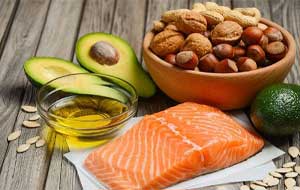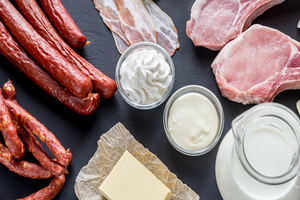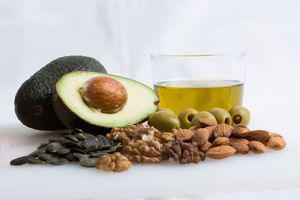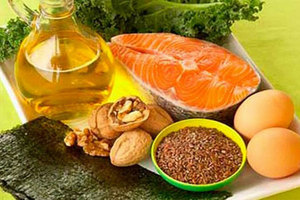A reliable source on many subjects.

A reliable source on many subjects.

![]()
 Fats are made up of several compounds and are generally soluble in organic solvents and insoluble in water.
Fats are made up of several compounds and are generally soluble in organic solvents and insoluble in water.
There are different types of fat: Good and bad!
In this article, we’ll explain how to recognize them and in which foods you can find them.
Fats’ is a term used to describe a wide range of different substances.
They are mainly
There are two main categories: saturated and unsaturated fats.
 Saturated fats look solid at room temperature, and are sometimes referred to as solid fats.
Saturated fats look solid at room temperature, and are sometimes referred to as solid fats.
They are totally saturated, which means that every molecule of fat is covered with hydrogen atoms.
Saturated fats increase health risks if a person consumes too much of them over a long period of time.
A high intake of saturated fats can eventually raise cholesterol levels, increasing the risk of cardiovascular disease and stroke.
The highest levels of saturated fat can be found in meat (mammalian), meat products, poultry skin, dairy products, many processed foods such as cakes, cookies, pastries and French fries, as well as coconut oil and cocoa butter.
A healthy diet includes less than 10% of calories from saturated fats.
That said, health professionals advise against replacing saturated fat intake with refined carbohydrates or sugar, as this can be detrimental to health [1].
Healthy alternatives include nuts, seeds, avocado, beans and vegetables.
Unsaturated fats are divided into monounsaturated and polyunsaturated fats.
They are liquid at room temperature and are mainly derived from vegetable oils. They are referred to as good fats.
 Monounsaturated fats can lower LDL (low-density lipoprotein) cholesterol, also known as bad cholesterol, and keep HDL (high-density lipoprotein – good cholesterol) levels higher.
Monounsaturated fats can lower LDL (low-density lipoprotein) cholesterol, also known as bad cholesterol, and keep HDL (high-density lipoprotein – good cholesterol) levels higher.
But if saturated fat intake is not reduced, these cholesterol levels may remain unchanged.
However, many health professionals claim that these fats may reduce the risk of developing heart disease.
For example, the Mediterranean diet, known for its effect on lowering the risk of chronic disease, is rich in monounsaturated fats.
Monounsaturated fats are found in olives, olive oil, sunflower oil rich in oleic acid, safflower oil rich in oleic acid, avocado, canola oil, peanut oil…
 Nutritionists say that polyunsaturated fats are good for your health, especially those found in fish, known as omega-3 polyunsaturated fatty acids.
Nutritionists say that polyunsaturated fats are good for your health, especially those found in fish, known as omega-3 polyunsaturated fatty acids.
Omega-3 fatty acids protect against heart disease by lowering blood cholesterol levels and possibly inflammation.
Health professionals say omega-3 polyunsaturated fatty acids can also help reduce symptoms experienced by people suffering from arthritis, general joint problems and certain skin diseases.
The other type of polyunsaturated fat is omega-6 fatty acids. These are found mainly in vegetable oils and processed foods.
Excessive consumption of omega-6s, which is common in the standard Western diet, can lead to increased inflammation.
Oily fish (sardines, mackerel, trout, salmon and herring), safflower, grapeseed, safflower, soy and sunflower oil.
Nuts, seeds and pastured eggs may also contain omega-3 fatty acids.
 Trans fats are synthetic, in other words they are not naturally produced.
Trans fats are synthetic, in other words they are not naturally produced.
Trans fats are created in an industrial process that adds hydrogen to liquid vegetable oils to make them more solid.
They are also known as partially hydrogenated oils.
Trans fats are not essential to human life, and they certainly don’t promote good health.
Worse, experts say trans fats from partially hydrogenated oils are hazardous to your health.
Consuming trans fats raises LDL cholesterol levels and lowers HDL cholesterol levels.
This, in turn, increases the risk of developing coronary heart disease and stroke threefold compared to other fats.
In fact, researchers estimate that trans fat intake is associated with around 50,000 fatal heart attacks every year. They are also associated with an increased risk of developing type 2 diabetes.
Trans fats have become popular because food companies find them easy to use and inexpensive to produce. They also last a long time and can make food taste good.
As trans fats can be used several times in commercial fryers, they are commonly used in fast-food outlets and restaurants.
In response to the potential health risks posed by trans fats, some local authorities have begun to ban their use.
Fried foods, such as French fries, doughnuts, pies, pastries, cookies, pizza dough, cookies, crackers, stick margarines, shortenings, packaged foods, fast food and many other cooked foods.
If the nutrition label includes partially hydrogenated oils, this means that the food contains trans fats.
Health authorities state that consumption of trans fats should not exceed 5-6% of total calorie intake, although any amount, however small, increases the risk of disease.
The bottom line is that not all fats are created equal.
Staying informed and reading labels can help you make good food choices, and replace unhealthy fats with healthy fats and fibrous plants.